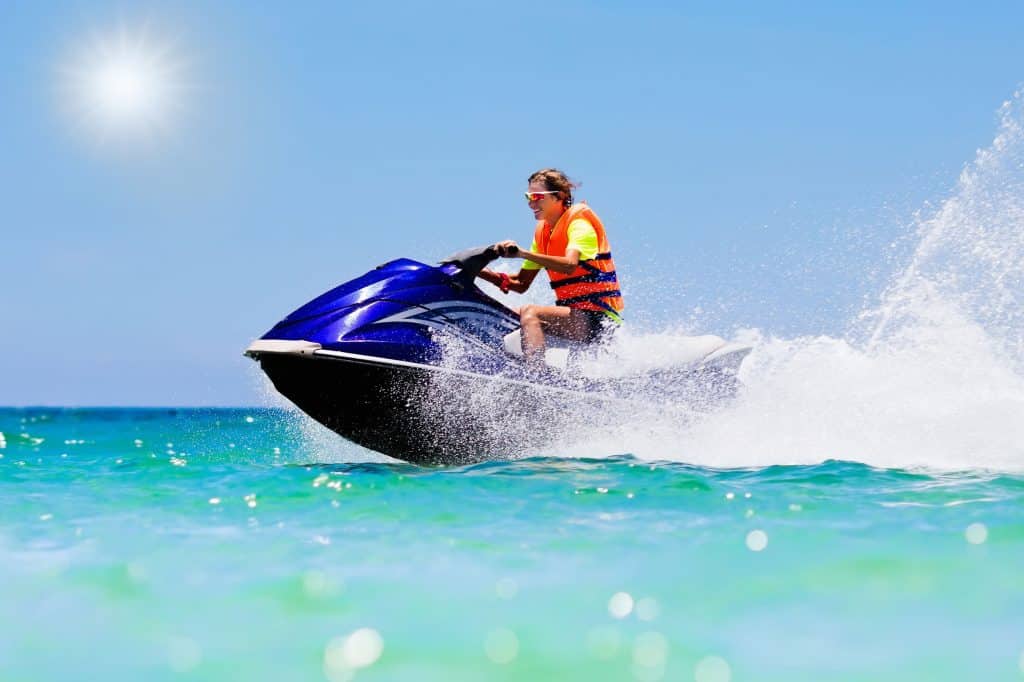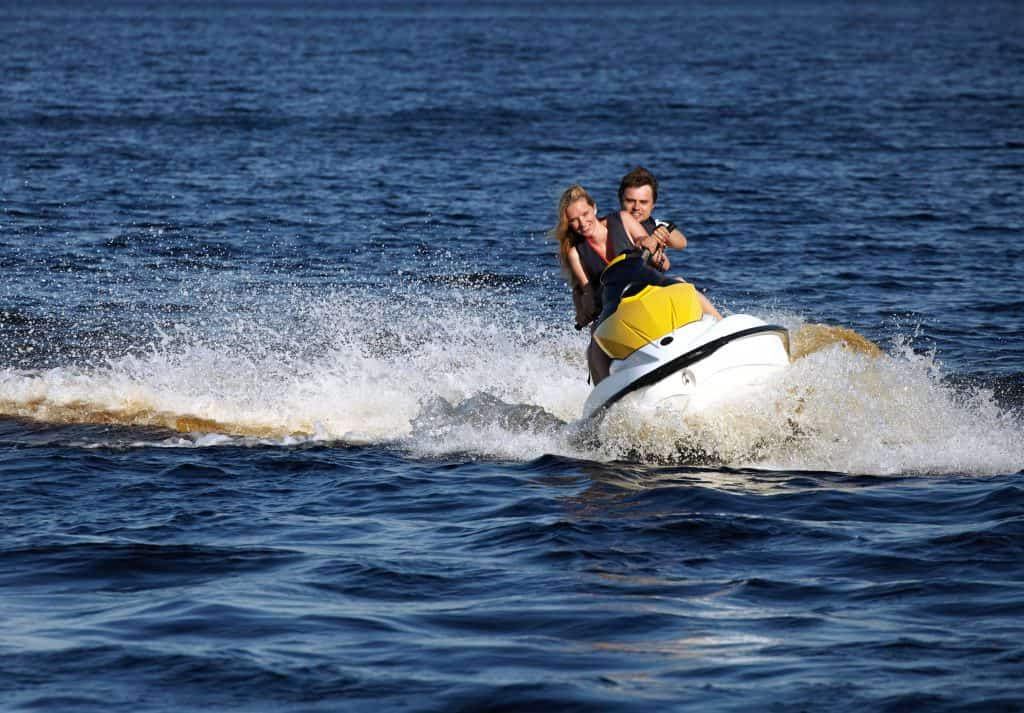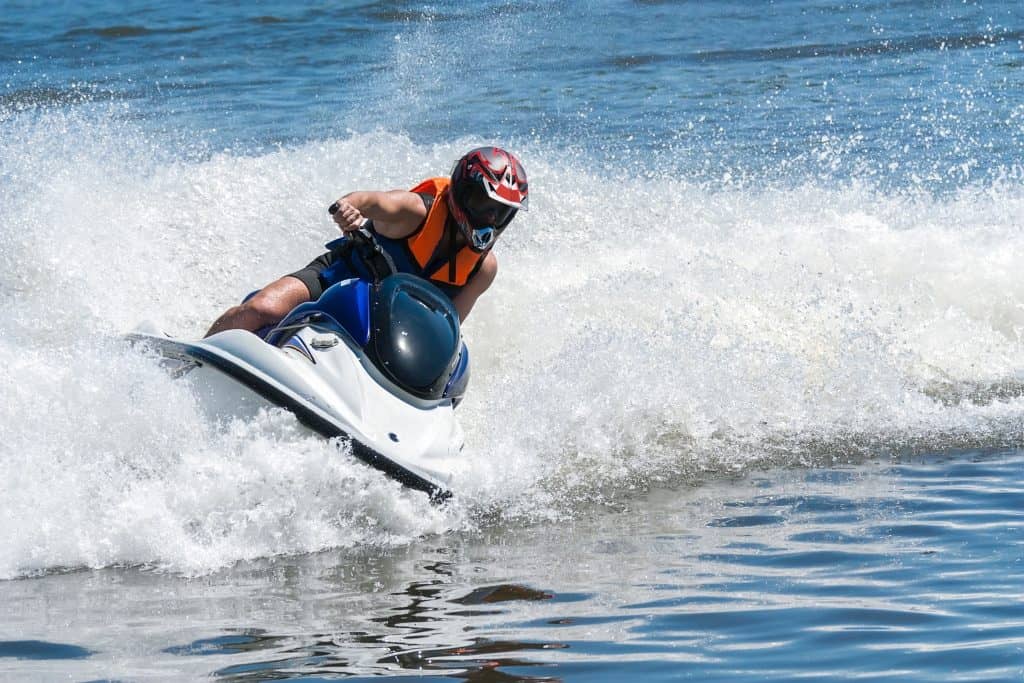Jet skiing in the summertime is a great way to make some cherished memories with family and friends. To make sure you do not come across any bumps with law enforcement while on the water you will need to know the rules and regulations for jet skiing in the state of Indiana. These rules can vary from state to state but it is a need-to-know in order to enjoy your time.
If you are 15 years old or younger you are not allowed to operate a PWC in the state of Indiana. Anyone 15 years old or older and they don’t have a driver’s license can operate a PWC if they complete the boating safety course prior to operating the vehicle.
It is important to be aware of the following regulations and laws for riding a jet ski on the water within the state of Indiana. By doing so you are responsibly following the law and that will guarantee you have an adventurous and stress-free time on your jet ski with family and friends.

Registering Your PWC
Indiana Registering Fees
| Original/Renewal Registration | |
| 13 feet or less | $15.00 |
| 13 feet up to 26 feet | $18.00 |
| 26 feet up to 40 feet | $21.00 |
| 40 feet or longer | $24.00 |
Numbers and Stickers
Once you receive your registration number and the validation stickers you must display these items in the following ways:
- There cannot be any other numbers shown on the bow of your vessel.
- The letters have to be separated from the numbers with a hyphen or space.
- Each number has to be painted, applied onto your vessel as a decal or placed to be shown on both sides of the bow.
- The number must be read from left to right on both sides.
- Each number must be in block letters and three inches high.
- The color of your numbers must also be in contrast to the color of your vessel.
Hull Identification Number
The Hull Identification Number (HIN) is a 12-digit number that is assigned by the manufacturer to vessel built after the year 1972. HIN helps be able to determine the difference between multiple vessels.
In case your vessel is stolen you should write down your HIN and place it somewhere safe and secure.

The Basics
PWC Rules and Regulations
- You cannot operate a PWC within 500 feet of a designated swimming area.
- Reckless operation of a PWC is not allowed. Examples of this are:
- jumping a wake too close to another vessel
- last minute avoidance of a collision
- weaving carelessly through traffic
- carrying more passengers on your PWC than is recommended
- if you maneuver your PWC in such a way that it can cause unreasonable harm to you or your passengers
- It is illegal to operate a PWC between the hours of sunset and sunrise especially when your vision is a bit restricted during the late hours
- You cannot remove any backfire flame arrestor or ventilator if it is installed by your manufacturer
- You must have a whistle or horn on board your PWC that is U.S. Coast Guard approved
- The safety ignition switch must be fully functional and have a lanyard attached to it to ensure it does not get lost or misplaced
- Each person on the PWC must wear a U.S. Coast Guard approved type 1,2, or 3 personal flotation device.
Alcohol and Drugs
In the state of Indiana you are considered to be under the influence if your blood alcohol concentration is 0.08% or higher. Though you can also be arrested if it is over 0.05%.
They enforce the following punishments for boating under the influence:
- On your first conviction you can face penalties from a Class C Misdemeanor. You may also lose the privilege of owning a operator’s license and that will last up to 90 days to two years.
- On your second offense within five years you can be fined, jailed and lose your operator privileges for up to two years.
- Any other offenses will result in more severe punishments.

Required Equipment
Personal Flotation Devices
| Type 1 | Offshore Life Jackets | This vest can turn an unconscious person in the water to face up in the water. It was made for rough waters and for situations where rescue might take a long time. |
| Type 2 | Near-Shore Vests | This vest is fit for calmer waters and faster rescues. If you were to wear this while unconscious it may not be able to turn your face up in the water. |
| Type 3 | Flotation Aids | This vest can also be a full-sleeved jacket and it is great for calm waters and fast rescues. This will definitely not turn your face up in rough waters. This is generally worn for water sports. |
| Type 4 | Throw able Devices | This type of flotation device is a cushion or ring buoys and are typically used to throw at someone in trouble. They are not made to last for long hours in the waters, or non-swimmers, or the unconscious. |
| Type 5 | Special-Use Devices | This type of flotation device was made for activities like kayaking, water-skiing These typically look like white water vests, deck suits, and personal flotation device hybrids. |
Requirements for PFDs
- A Type 4 personal flotation device that is approved by the U.S> Coast Guard, must be on board a vessel that is 16 feet or longer and it must also be easily accessible for emergency use.
- Any person that is on board a PWC or vessel (no matter the age) must wear a PFD.
- Vessels have to have 1 of the 5 personal flotation devices on board and they also must be a wearable size for any passenger or operator.
Fire Extinguishers
You can classify your fire extinguishers by letter and number symbol The number is there to help you decipher the size of your extinguisher, and the letter is there to help you indicate the type of fire that extinguisher can put out.
| TYPE A FIRES | TYPE B FIRES | TYPE C FIRES |
| These types of fires are combustible solids such as wood | These types of fires are flammable liquids like gasoline or oil | This type of fire is mainly electrical fires |
These fire extinguishers must stay in a usable condition. You need to regularly check up on the extinguishers to ensure they are in the best condition:
- There is no physical damage, corrosion, leakage or clogged nozzle
- Pressure gauges or indicators read in the operable range
- Seals and tamper indicators are not broken or missing
If an Accident Occurs…
The operator of the vessel must file an accident report form to the Department of Natural Resources in Indiana if one of the following occurs:
- A person dies
- A person disappears
- A person is injured or is in need of medical treatment
- Or if there is damage to a vessel or property that exceeds $750
If you fail to file an accident report to the department you can receive a Class A misdemeanor.
Be sure to also file this report within 24 hours of the accident.
Law Enforcement
The law enforcement officers of Indiana control the federal waters you partake in. These officers have the authority to stop your personal watercraft vehicle in order to make sure that you are abiding by the laws posted on the water.
It is illegal to refuse their directions and they are have you submit to a breath test to make sure you are not boating under the influence.
